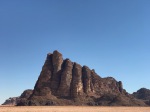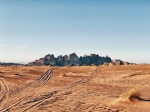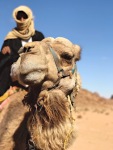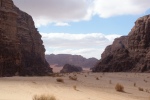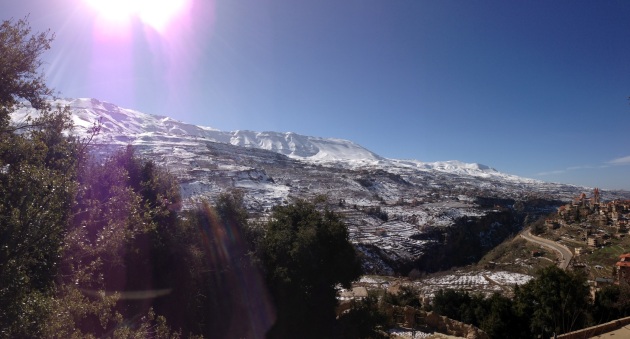As far as other Arabs are concerned, Lebanon is considered to be the greenest of the region’s countries, and despite rampant deforestation and grossly non-environmentally friendly governmental policies, this is actually the case for our little country. Our biggest asset in bringing people to visit us from the region isn’t, therefore, only our “joie de vivre,” nightlife and awesome food, but the fact that we offer them eco-tourism that their countries can’t match. Alas, Lebanon tends to take its tourism for granted.
I was recently in Jordan for a few days during which I had the chance to see some of the country’s main touristic attractions, including their 7 wonders of the world site Petra, and the place that stuck in my head to this very day and the place that I would want to visit again as soon as I can and recommend that everyone do so: Wadi Rum.
Wadi Rum is not unfamiliar with many of you. You’ve actually seen it plenty of times before but didn’t know it was the case. It’s featured heavily in the latest Star Wars movie “Rogue One.” It was the filming site of Best Picture nominee “The Martian.” It was also where parts of the second Transformers movie, Indiana Jones and Lawrence of Arabia were filmed.
Simply put, Hollywood and Westerners know Wadi Rum exists and flock to it in droves. For other Arabs and Lebanese, however, the place remains near-fictive. When I mentioned that I’d love to visit the place a few months ago, the reply I got was: “what’s there to see in the desert?”
The answer is: quite a lot.
The reputation that we, as Lebanese, have when it comes to our tourism style is that we’re not adventurous. We want good food, nightlife and shopping. To me, that reputation is horrific. I asked many travel agencies about that reputation and all of them corroborated it: this is what they sell. I guess this doesn’t apply to a newer generation of Lebanese, and many of this blog’s readers, but I daresay it’s high time to change that.
-
How To Get To Wadi Rum:
A new travel path between Beirut and Jordan was launched last week, offering direct flights between Beirut and Aqaba for $212 round trip. This path is better than Beirut – Amman because Aqaba is much closer to Wadi Rum than Amman (70km versus 300km).
Once you get to Aqaba, it’s quite easy to rent a car. Your Lebanese driver’s license actually works, or you can have an international driver’s license done to be on the safe side. Oil prices in Jordan are much cheaper than their counterpart back home and car rental prices are super cheap too.
-
What To Do In Wadi Rum:
The Wadi Rum reserve is huge. It’s around 700km2. I daresay there’s no way that anyone can do the whole thing in one stay unless they stay there for a couple of weeks, and that’s not ideal because it’s a physically demanding visit.
Gorgeous scenery: While we, as Lebanese, completely disregard the jewels we have interspersed in our country and don’t bother in their upkeep, the Jordanians have done the total opposite with Wadi Rum: it is a natural reserve that is so clean, so neatly kept and so beautiful. Wadi Rum is the total opposite of the kind of eco-tourism that we can offer in Lebanon: it’s a desert, filled with gorgeous sand dunes, high limestone mountains, sitting on one of Arabia’s biggest aquifers, and is as authentic as a desert experience can be. Your instagram posts will be ace, trust me.
Safari rides: Forget safaris in Dubai. I went on a 4×4 truck ride across the area and this is the real deal. You sit in the back of the pickup truck, and a skilled driver takes you around gorgeous scenery that will leave you dumbfounded. Refer to pictures below.
Bedouin life: Wadi Rum is also home to many Bedouin tribes that still live there. Those tribes will open their arms to you and host you for lunch or dinner. Their cooking style is very interesting in that, to save up on wood, they bury their cooking pots in the sand with the burning embers and let the meat and vegetables slowly cook. I had the pleasure to sit with a Bedouin tribal chief who told us stories of life in the desert, played a little on his rababa and invited us to share a meal with him.
Camel Riding: Western countries also stereotype our countries as the places were camels are the go-to mode of transportation. They’d be disappointed, I suppose, to find out that the first time I’ve ever ridden a camel was in Wadi Rum.
Hiking: I didn’t have the chance to do a lot of hiking at Wadi Rum but there are trails all around the place that vary based on difficulty that those who like hiking will find to be exquisite. My fair share of rock climbing and hiking that I did there was unforgettable, although my legs would probably ask for a break before I do that again.
Sunsets: There’s something to say about the beauty of sunsets and desert sunsets have their own taste that I’m super glad I got to experience. I was able to sit atop one a high rock with a view, look over at a huge landscape in front of me as it turned into hues of gold and orange.
Star Gazing: After the sun set, I was treated to one of the most beautiful starry skies I’ve ever seen. Entire constellations spread in front of you. Just lie there, and enjoy the gorgeous view.
-
Where To Stay:
You don’t need to go back to the city in order to enjoy Wadi Rum for more than a day. The place has many camping sites interspersed here and there, with prices for the night being around $20.
Why It’s a Must Visit:
I can’t begin to tell you how amazing the place is. I spent an entire day there – from 8AM till around 10PM – and left feeling disheartened because I wanted to spend more time and see more places. Apart from it being historic with it being one of the places that Lawrence of Arabia spent a lot of time and its rocks having many ancient inscriptions on them, Wadi Rum offers you quite an experience that Lebanon doesn’t have and I daresay other Arab countries of the region can’t match. It’s unfortunate that this jewel in the Middle East is discovered and used quite often by Hollywood and Europeans but not by the locals or those from neighboring countries like us. It’s cheap, quite accessible with no visa requirements for entry for Lebanese, and you’ll go back to Lebanon with many a chance to tell wonderful stories of your desert excursions. Go there!



